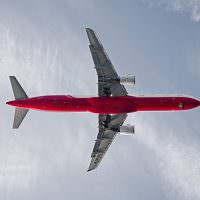Weather delays can be extremely frustrating when you are trying to get somewhere. Likewise, passengers with a fear of flying may feel a bit anxious about traveling to an airport or region that is experiencing storms. Fortunately, there is nothing to worry about, as all modern airliners can operate safely in pretty much any kind of weather. Regardless, flights are still routed around weather, mainly for passenger comfort. So, that being said, how in the world can a delay caused by weather possibly be a good thing?
In short, the delay is increasing the safety of your flight by reducing the chances that you will have to enter a holding pattern or be diverted to an airport other than your destination. Many years ago, if there was a storm near a region or airport, Air Traffic Control (ATC) and the airlines made little effort to restrict the number of flights headed to that particular airport. All the planes flying to that city simply took off as scheduled and flew in that direction. As the planes neared that airport or surrounding areas, the “airways” became flooded with more planes and traffic than they could handle. This meant that some of the planes were forced to hold until the airways had adequate spacing between planes. Of course, all airline flights are required by law to have a certain minimum amount of extra fuel onboard for these situations, which is still true today. Unfortunately, many times there were simply too many planes heading to an airport with no way to accommodate all of them. So, after holding for several minutes or several hours, some planes were then forced to divert to alternate airports. The pilots would do this to get additional fuel or wait for the airways to open back up after the storm had passed. This meant that a bad storm could delay your flight for many hours or maybe even an entire day. Worse yet, your flight could end up diverted to another airport and subsequently cancelled altogether.
Today, the current policy makes much more sense as it holds a given flight on the ground until it is essentially assured an arrival and landing slot at its destination. While this tactic still causes a delay, it is usually much shorter than if every plane was trying to fly to an airport at the same time. Holding an aircraft at the gate provides an additional comfort benefit to passengers. Instead of being relegated to sitting on the plane for hours, passengers can remain in the terminal with better access to restaurants, restrooms, and other amenities. More importantly, this means that when you do takeoff, the airspace around your destination will have sufficient room for your flight. This reduces or eliminates the time that your flight may spend in a holding pattern and all but guarantees that you will land at your destination instead of diverting.
Ultimately, the current weather delay system reduces uncertainty, increases safety, and shortens the overall delay. This way, you spend more of the delay sitting on the ground with better access to amenities, while simultaneously improving your chances for getting where you want to go. I think most people would agree that this sounds much better than being delayed in a holding pattern at 30,000 feet and hoping that your flight will make it to your destination without being diverted. As always, whether the delay is due to weather or some other factor, the primary emphasis will always be safety. Airlines, pilots, and everyone else involved with the air travel process realize that your time is valuable, but they also recognize that your safety and your life are worth more than anything else. The policies and procedures governing air travel reflect that belief.






